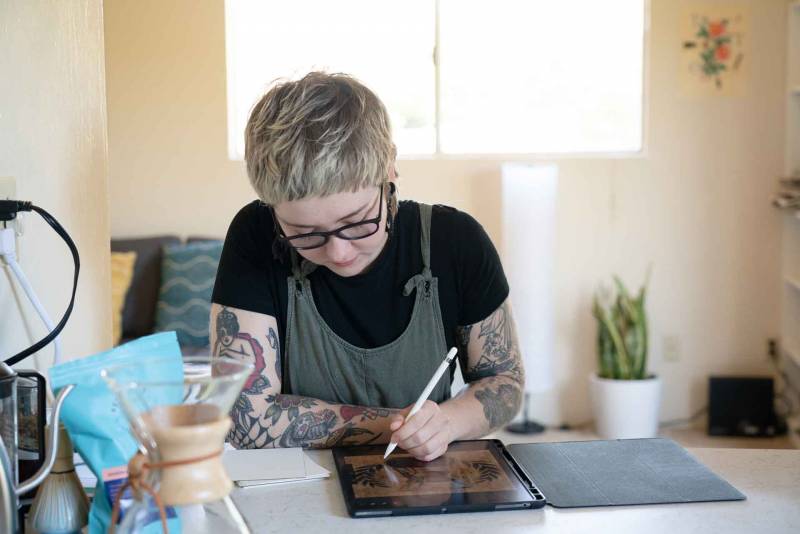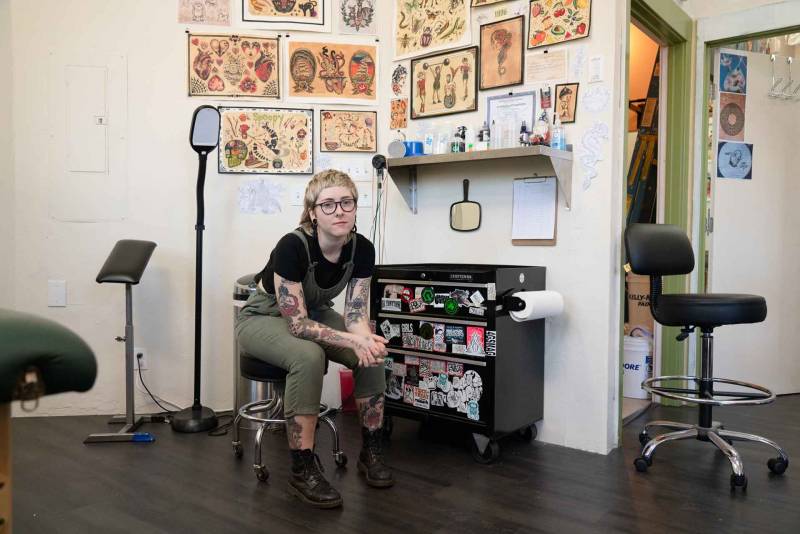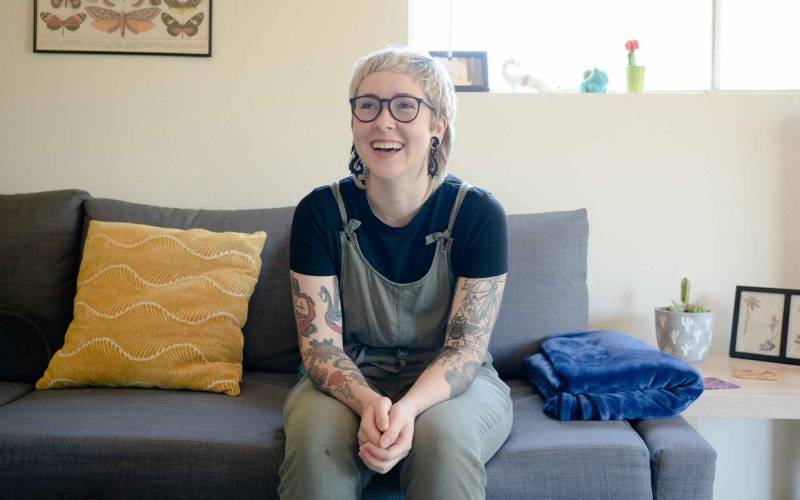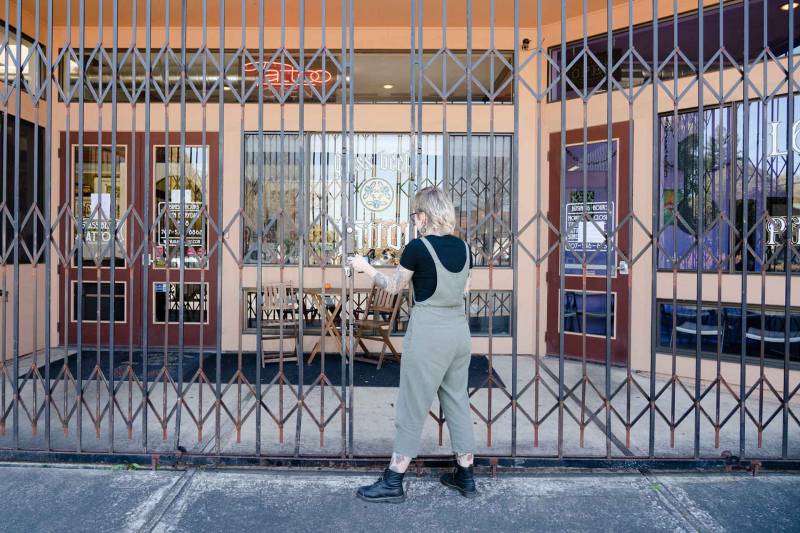Pierce agreed to self-quarantine in her own home for the next 14 day, and forgo any income. After taking a vacation, Pierce was finally able to return to work after a week without any income.
Now, sitting on the couch in a $1,400-a-month, 600-square-foot Santa Rosa apartment she just started renting with her boyfriend, Pierce doesn’t know when she’ll be able to work again.
Along with over 6 million others in the United States, she’s filed for unemployment. And she considers herself lucky to have a cushion of money saved up—about $10,000.
“Which is not that much,” she says. “But I feel like for someone my age, at 23, it’s a lot.”
It is hoped that it will be sufficient. Pierce does not know when the shop will reopen. When it does, “I think it’ll be slow, especially walk-ins,” she says, aware that people may be cautious of skin-to-skin contact with strangers. “Everything will be different. It’s worrying.”

Income and expenses
It’s a marked change from the upward trajectory of the young tattoo artist’s career. Pierce had been consistently booked out two-to-three weeks in advance at Santa Rosa’s Glass Beetle Tattoo, bringing in an average of $700–$900 a week.
“So sometimes as much as $4,000 a month. And that’s after taxes, plus cash,” she says.
Pierce was also able to benefit from the changes made at the shop by AB5, a California assembly bill that would reclassify independent contractors and gig workers as employees. While other rent-your-station businesses like hair salons, barber shops and tattoo parlors struggled with the bill’s byzantine restrictions, the owner of Pierce’s shop simply put everyone on payroll and proposed a commission model. Pierce gets 40% and the shop 60% for each tattoo she does. Plus tips.
Pierce, just like many restaurant servers, lives off cash tips to pay for her day-to-day needs. She and her boyfriend spend $100–$200 a week on groceries (a book laying on her shelf is titled 101 Things to do with Ramen Noodles). She spends $250 per month on the car, including her insurance and loan payments on her 2017 Mistubishi mirage. A therapist helps with the stress of work (“I recommend it literally for everyone,” Pierce says); she pays on a sliding scale at $40–$60 a week.
 Emma Pierce at her station. It has been empty ever since the closing of the tattoo shop. (Graham Holoch / KQED)
Emma Pierce at her station. It has been empty ever since the closing of the tattoo shop. (Graham Holoch / KQED)Pierce is able to save money in many other ways. An iPad Pro used for $500 was purchased on eBay. This is half the price of a new iPad Pro. Pierce uses it to draw tattoos during appointments. When she’s working, she has enough bookings that she doesn’t need to pay for Instagram ads, and the shop owner buys communal supplies like needles, tubes, inks, gloves and paper towels. And she’s still covered under her mom’s health insurance plan for another month.
For young people, her most important advice is to make a direct deposit into your savings account. She automatically deposits 10% of every paycheck into her savings. “It’s really helpful, you don’t have to even think about it, and then you have a little bit in savings after a while,” she says.
She did note that she was fortunate to have lived with her mom for a month and not to have been in financial hardship. But she also works hard, coming home from work at 8 or 9pm and then drawing the next day’s appointments until midnight.
Pierce could be described as hardworking, considering how she learned tattooing.
 Emma Pierce in Santa Rosa at her apartment. The shutdown of the coronavirus has prevented Emma Pierce, a tattoo artist at 23, from working for several weeks. (Graham Holoch / KQED)
Emma Pierce in Santa Rosa at her apartment. The shutdown of the coronavirus has prevented Emma Pierce, a tattoo artist at 23, from working for several weeks. (Graham Holoch / KQED)How to Get her started
Pierce was in college when she got her first tattoo, the mention of which evokes an embarrassed “God, ooooooooohhhhhh!” from its owner. “It’s the feminist symbol, with the fist,” she says, sheepishly. “It’s the typical liberal college arts kid thing.”
However, she was still fascinated with tattoos. She would give herself a few stick and pokes and hang out in shops. She knew that she wanted to be a tattoo artist and decided to go to Santa Rosa Junior College instead. She found a mentor who was willing to let her join Glass Beetle as an apprentice.
Most tattoo artists get their start as an apprentice, and it’s not easy: Pierce put in 40 hours a week for a year, and paid $1,400 up front and $200 per month for the experience.
“It was hard,” Pierce says. “I was a softie, and that’s not good for a tattoo shop.”
Pierce heard of other apprenticeships costing $5,000–$10,000, and lasting over two years, but she picked up skills quickly and had a good mentor who was hard on her in all the right ways.
“If you’re gonna be a tattoo artist, you have to be able to tell people ‘this is not a good idea’ or ‘this is not gonna work.’ You have to be able to assert yourself and be confident in what you’re saying. I was not confident. He did a really good job in hammering out the soft, cushy attitude I had,” Pierce says.
She worked in a coffee shop between 6am and noon to make $12 an hour, plus tips, during her apprenticeship. She would then go to the tattoo shop to finish eight to ten more hours of tattooing, clean-up, and more.
“I had it pretty easy, compared to how it used to be,” Pierce says of her apprenticeship. “It used to be abuse, like, straight-up hazing. I didn’t have it that bad.”

What’s next?
Pierce has reduced her spending since the shop is closed. She has houseplants, kitchen utensils, and manga books in her newly decorated apartment. This is evidence of her modest hobbies during her shelter-in place order. When she’s not watching anime or talking to her mom, she draws at the kitchen counter, an ad hoc work station.
Her boyfriend works at a local winery where he earns $20 an hour. Since the tasting room that he used to manage is now closed, he is helping out in the warehouse. Pierce still hasn’t received any unemployment, but she’s been notified she’ll get $450 a week, the state maximum. It is possible that the $600 extra promised by Governor Newsom will be included in it. The federal stimulus payment of $1,200 seems distant. “It’s going to be interesting not having income,” Pierce says.
Pierce, who was used to working hard feels a bit rootless.
“I haven’t been online shopping. I haven’t been going out,” she says. “I’m just not spending money, because I’m just sitting at home doing nothing.”
